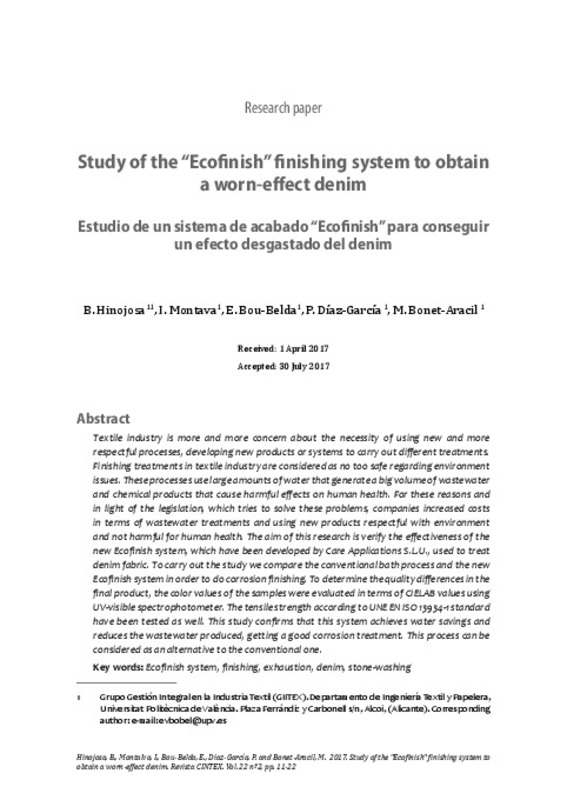JavaScript is disabled for your browser. Some features of this site may not work without it.
Buscar en RiuNet
Listar
Mi cuenta
Estadísticas
Ayuda RiuNet
Admin. UPV
Study of "Ecofinish" finishing system to obtain a worn-effect denim
Mostrar el registro sencillo del ítem
Ficheros en el ítem
| dc.contributor.author | Hinojosa, Belen
|
es_ES |
| dc.contributor.author | Montava-Seguí, Ignacio
|
es_ES |
| dc.contributor.author | Bou-Belda, Eva
|
es_ES |
| dc.contributor.author | Díaz-García, Pablo
|
es_ES |
| dc.contributor.author | Bonet-Aracil, Marilés
|
es_ES |
| dc.date.accessioned | 2019-06-07T20:07:04Z | |
| dc.date.available | 2019-06-07T20:07:04Z | |
| dc.date.issued | 2017 | es_ES |
| dc.identifier.issn | 0122-350X | es_ES |
| dc.identifier.uri | http://hdl.handle.net/10251/121794 | |
| dc.description.abstract | [ES] La industria textil está cada vez más concienciada sobre la necesidad de utilizar nuevos y más respetuosos procesos desarrollando nuevos productos o sistemas que lleven a cabo diferentes tratamientos. El sector de los procesos de acabado y tintura son considerados como no demasiado respetuosos para el medioambiente. Estos procesos utilizan gran cantidad de agua que genera un gran volumen de aguas residuales, además de utilizar productos tóxicos para el ser humano y para el ser humano. Por estas razones y atendiendo a la legislación que intenta solucionar estos problemas, las empresas están incrementando los costes debido al tratamiento de aguas residuales y la utilización de nuevos productos biodegradables o que no sean perjudiciales para la salud del ser humano. El objetivo del presente trabajo se centra en verificar la efectividad del nuevo sistema Ecofinish, el cual ha sido desarrollado por la empresa Care Applications S.L.U., utilizado para el tratamiento de corrosión de tejidos denim. Para llevar a cabo el estudio se comparan las muestras tratadas con el sistema de agotamiento convencional en prenda y tratadas mediante éste sistema pero con el sistema Ecofinish instalado. Con el fin de determinar las diferencias resultantes en las muestras obtenidas se estudian los parámetros colorimétricos en el espacio de color CIELAB utilizando el espectrofotómetro de UV visible. Se ha estudiado el comportamiento mecánico de las muestras realizando el ensayo de resistencia a la tracción de acuerdo a la norma UNE EN ISO 13934-1. Los resultados obtenidos confirman que el sistema Ecofinish consigue, además de ahorros considerables en el baño de tratamiento y reducir la cantidad de aguas residuales producidas, resultados similares o incluso mejores que el sistema convencional en el tratamiento de corrosión. Por lo que este sistema puede ser considerado como una alternativa al sistema de tratamiento convencional. | es_ES |
| dc.description.abstract | [EN] Textile industry is more and more concern about the necessity of using new and more respectful processes, developing new products or systems to carry out different treatments. Finishing treatments in textile industry are considered as no too safe regarding environment issues. These processes use large amounts of water that generate a big volume of wastewater and chemical products that cause harmful effects on human health. For these reasons and in light of the legislation, which tries to solve these problems, companies increased costs in terms of wastewater treatments and using new products respectful with environment and not harmful for human health. The aim of this research is verify the effectiveness of the new Ecofinish system, which have been developed by Care Applications S.L.U., used to treat denim fabric. To carry out the study we compare the conventional bath process and the new Ecofinish system in order to do corrosion finishing. To determine the quality differences in the final product, the color values of the samples were evaluated in terms of CIELAB values using UV-visible spectrophotometer. The tensile strength according to UNE EN ISO 13934-1 standard have been tested as well. This study confirms that this system achieves water savings and reduces the wastewater produced, getting a good corrosion treatment. This process can be considered as an alternative to the conventional one. | es_ES |
| dc.language | Inglés | es_ES |
| dc.publisher | Institución Universitaria Pascual Bravo | es_ES |
| dc.relation.ispartof | Revista CINTEX | es_ES |
| dc.rights | Reconocimiento (by) | es_ES |
| dc.subject | Finishing | es_ES |
| dc.subject | Exhaustion | es_ES |
| dc.subject | Stone-washing | es_ES |
| dc.subject | Cotton | es_ES |
| dc.subject.classification | INGENIERIA TEXTIL Y PAPELERA | es_ES |
| dc.title | Study of "Ecofinish" finishing system to obtain a worn-effect denim | es_ES |
| dc.title.alternative | Estudio de un sistema de acabado Ecofinish para conseguir un efecto desgastado del denim | es_ES |
| dc.type | Artículo | es_ES |
| dc.rights.accessRights | Abierto | es_ES |
| dc.contributor.affiliation | Universitat Politècnica de València. Departamento de Ingeniería Textil y Papelera - Departament d'Enginyeria Tèxtil i Paperera | es_ES |
| dc.description.bibliographicCitation | Hinojosa, B.; Montava-Seguí, I.; Bou-Belda, E.; Díaz-García, P.; Bonet-Aracil, M. (2017). Study of "Ecofinish" finishing system to obtain a worn-effect denim. Revista CINTEX. 22(2):11-22. http://hdl.handle.net/10251/121794 | es_ES |
| dc.description.accrualMethod | S | es_ES |
| dc.relation.publisherversion | https://revistas.pascualbravo.edu.co/index.php/cintex/issue/view/26 | es_ES |
| dc.description.upvformatpinicio | 11 | es_ES |
| dc.description.upvformatpfin | 22 | es_ES |
| dc.type.version | info:eu-repo/semantics/publishedVersion | es_ES |
| dc.description.volume | 22 | es_ES |
| dc.description.issue | 2 | es_ES |
| dc.relation.pasarela | S\381044 | es_ES |






